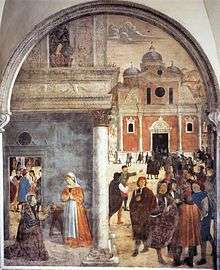Antonio Solario

Antonio Solario (active perhaps 1502–1518), also known as Lo Zingaro (The Gypsy) was an Italian painter of the Venetian school, who worked in Naples, the Marche and possibly England.
His career is obscure, largely pieced together from surviving works, and at one time his existence was doubted.[1] He is often referred to also as Antonio de Solario or Antonio da Solario,
He was possibly born and probably trained in Venice, and signed the Withypool Altarpiece "Antonius Desolario, Venetus 1514"; this includes a donor portrait and the heraldry of the London merchant Paul Withypool. This work and other references to works in England by John Leland a few decades later are the evidence for his putative English visit. The altarpiece is in the Bristol City Museum and Art Gallery who own the main panel; the wings have been loaned by the National Gallery,[2] who also have a Virgin and Child.[3] There is a similar but smaller panel of the Madonna and Child with a Donor in the National Museum of Capodimonte at Naples.[4] All include charming small landscapes seen through windows in a wall behind the figures.
He is first recorded at Fermo in 1502, and last (rather questionably) in Montecassino in 1518;[5] if this last is excluded his last known date is 1514. In Naples, his main work were twenty large frescoes illustrating the Life of St Benedict in the cloister of the monastery of Santi Severino e Sossio (now the State Archives), which are open to the elements though covered and are now greatly decayed; they present a vast variety of figures and details, with dexterous modeling and coloring. These were painted in the first years of the century. Sometimes Solario's color is crude, and he generally shows weakness of draughtsmanship in hands and feet. His tendency is that of a naturalist the heads lifelike and individual, and the landscape backgrounds better invented and cared for than in any contemporary.
His works are sometimes confused with those of his contemporary, Andrea Solario, a Milanese follower of Leonardo da Vinci. While not related to this painter, Antonio probably met and was influenced by Andrea. The portrait of Charles II d'Amboise in the Louvre, who now attribute it as a copy of a work by Andrea, is a case in point.[6]
Unfortunately, the only biography of Solario written by a local personage, was penned by Bernardo de' Dominici (1683–1759), the "Neapolitan Vasari", who wrote an often confused and error-ridden Vite dei Pittori, Scultori, ed Architetti Napolitani. It states that Solario was born in about 1382, probably in Abruzzo. He is called the son of a tinker, and, after a romantic interlude, became son-in-law of Colantonio, the leading artist in the mid-15th century Naples.[7] Dominici claims Solario died in 1455.[8] The erroneous chronology was not clarified until the twentieth century.
Footnotes
- ↑ Davies, 292; Ettore Modigliani, A Madonna by Antonio da Solario, and the Frescoes of SS. Severino e Sosio at Naples, The Burlington Magazine, Vol. 11, No. 54 (Sep., 1907), pp. 376-377+381-382, JSTOR goes into some of the issues.
- ↑ National Gallery Loan
- ↑ Marks, 275; Davies, 292-294; images of this and other works
- ↑ Spinosa, 79
- ↑ Davies, 292
- ↑ Louvre
- ↑ De Dominici, Bernardo (1742). Vite dei Pittori, Scultori, ed Architetti Napolitani (2 volumes). Stamperia del Ricciardi, Naples; Digitized by Googlebooks from Oxford University copy on February 1, 2007. pp. 118–141.
- ↑ Summary of Account.
References
- Davies, Martin, National Gallery Catalogues: Catalogue of the Earlier Italian Schools, National Gallery Catalogues, London 1961, reprinted 1986, ISBN 0-901791-29-6
 This article incorporates text from a publication now in the public domain: Chisholm, Hugh, ed. (1911). "article name needed". Encyclopædia Britannica (11th ed.). Cambridge University Press.
This article incorporates text from a publication now in the public domain: Chisholm, Hugh, ed. (1911). "article name needed". Encyclopædia Britannica (11th ed.). Cambridge University Press.- Marks, Richard and Williamson, Paul, eds. Gothic: Art for England 1400-1547, 2003, V&A Publications, London, ISBN 1-85177-401-7
- Nicola Spinosa (ed), The National Museum of Capodimonte, Electa Napoli, 2003, ISBN 88-510-0007-7